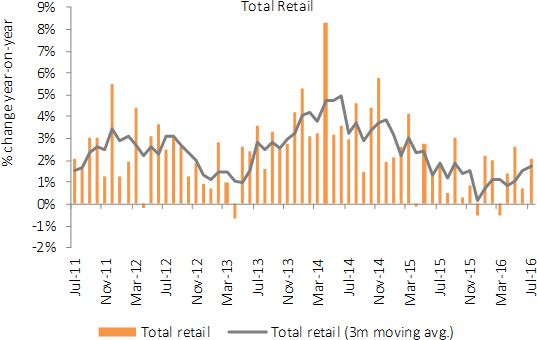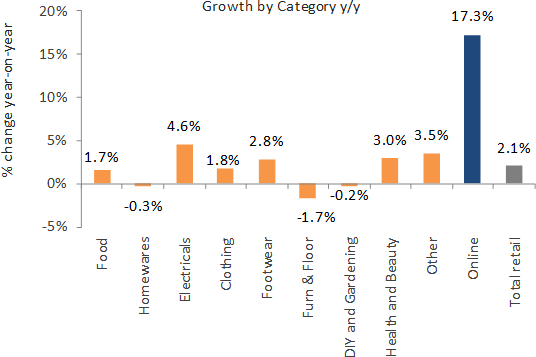Shoppers defy warning of collapse in consumer confidence
Retail sales rose by 2.1 per cent year-on-year (non-seasonally adjusted) in July, according to the Retail Economics Retail Sales Index. The three month rolling average, which provides a more accurate underlying trend, showed sales rose by 1.7 per cent, the fastest growth since September 2015.

Source: Retail EconomicsDespite numerous consumer polls suggesting a sudden loss of confidence, including our own, shoppers have defied the surveys and were out in force in July. We did, however, point out last month that what consumers say they are going to do and what they do in reality are two entirely different prospects. Nevertheless, these latest sales figures are stronger than expected and suggest that consumers remain resilient despite ongoing uncertainty about the impact of Brexit and the knock-on effect on the UK economy.

Source: Retail EconomicsElectricals was the fastest growing category and had another strong month with sales growth up 4.6 per cent on the previous year, according to the Retail Economics Retail Sales Index. However, sales have slowed on the three-month average of 5.9 per cent and are markedly weaker than the 12-month average of 6.9 per cent. Anecdotal evidence suggests that the summer of sports which included the Euro 2016 tournament, Wimbledon and the Rio Olympics supported the sales of big screen TVs. In addition, computing and communications remained in high demand.Food also continued its revival with sales rising by 1.7 per cent in July on the previous year. Warmer weather helped the sale of summer foods for barbeques and picnics.Clothing and Footwear also benefited from the warmer weather which boosted the sale of summer lines. However, with clothing retailers now concentrating on Autumn ranges and back-to-school, spending was largely on discounted summer stock which came to the detriment of margins. Furniture and Flooring and Homewares were the poorest performers with sales growth declining by 1.7 per cent and 0.3 per cent, respectively. This is likely a reflection of the housing market downturn as consumers delay purchases in the face of heightened uncertainty. Furthermore, the warmer weather inspired shoppers to hit the high streets, according to Springboard footfall figures, and retail park footfall fell in July, for just the second time since December 2013. Nonetheless, overall retail spending exceeded our expectations and leave a glimmer of hope that consumers turn out to be more resilient than many forecasters are warning. Indeed, ahead of the EU Referendum the expectations from many economists suggested the economy would weaken further, firms would freeze hiring and investment plans would be reined in. We now know that the economy actually accelerated, growing 0.6 per cent in Q2 2016 from 0.4 per cent in the previous quarter, and the UK labour market continued its robust performance adding 172,000 jobs in the last three months - which was preceded by a punchy 111,000 increase in the previous month. If these figures are anything to judge by, pre-Brexit jitters were unfounded which provides hope that post-Referendum doom-mongers may prove equally unjustified. Granted, investment data is still yet to be released to cover the period which may prove telling. Our fears for the strength on the consumer sector are anchored to the impact on the real economy.Given just two months have passed since the decision to leave the EU, households’ disposable incomes are unlikely to have changed. It will take time for the repercussions of the vote to work their way through to the real economy in terms of jobs, higher inflation and lower economic output. Put simply, the consumer sector is dependent on household’s spending power and their propensity to spend. On the whole, consumers react to their personal experience of the economy in terms of their job security, rising prices in the shops and what happens to their wages. As of yet, not much has happened to affect either spending power and, judging by this latest data, their propensity to spend. However, the longer-term implications of weaker business investment and the knock-on effect this has on jobs, wages, inflation and the real economy is much more difficult to judge. Once households feel the impact of rising costs of living, weaker job security and wage growth, rising unemployment and a weaker economy, they are likely to react negatively. The reaction from business appears to have differed significantly. Survey evidence suggests that companies are holding back on hiring and investment decisions in anticipation of choppier waters ahead. The Markit/CIPS survey of business activity recorded its sharpest fall since the financial crisis in July. The service sector, a dominant component, fell at its fastest rate in more than seven years. Data on hiring intentions from the Recruitment and Employment Confederation said that its labour market survey recorded a “dramatic free fall” in July with permanent hiring dropping to levels last seen in the 2009 recession. That said, the Monetary Policy Committee (MPC) has taken bold action in supporting the economy by cutting the Bank Rate to a new record low of 0.25 per cent and increased its stimulus package by extending quantitative easing. It has also introduced a new “term funding scheme” designed to ensure the rate cut is passed on to borrowers. For households, the rate cut should reduce the interest paid by existing mortgage holders with a floating rate. In addition, it should also lower the interest rates charged on new loans which should encourage more spending. However, the transmission of lower rates tends to be slow given half of all mortgages, by value, are floating-rate contracts and the remaining, fixed-rate mortgages, will be refinances over time. This means it may take up to two years before this part of the market sees any impact from lower rates. However, in theory, the transmission of lower rates for non-financial firms should be much faster. Non-financial firms had bank loans totalling £440 billion in June, with four-fifths at floating rates. Lower borrowing costs should encourage more investment which will support jobs and the overall economy. While the Bank’s accommodative stance on monetary policy is welcome news, it is still far too early to judge whether this support, without coordinated fiscal policy, will prove successful. It is likely that the Autumn Statement will rebalance the current austerity plans and, in light of more data that will emerge over the coming months, could introduce a new fiscal framework to support economic growth in a post-Brexit economy. But, as the mathematician, John Allen Paulos said, “uncertainty is the only certainty there is, and knowing how to live with insecurity is the only security.”
Back to Retail Economic News